From The CRPG Addict
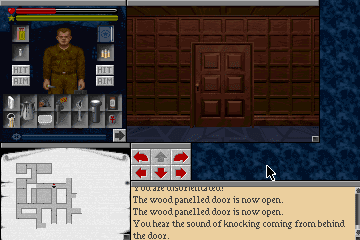 |
| The most legitimately scary moment in the game so far. |
I’m not an adventure game addict. My experience with them is somewhat limited to the few that I played as a child and they hybrids I’ve played on this blog. What I enjoy most about them are the “aha!” moments when you realize the solution to a puzzle and, even better, when that solution cascades to other puzzles. It feels like when I’m playing a tough crossword and just starting to despair and I finally hit upon a word, and the letters that it gives me in the crossings lead to a cascade of “aha!s” as I fill in a bunch of other words. There are many times in adventure games in which I have a list of puzzles with no solutions and then suddenly solving one provides me with the object I need for another, which provides me with the object I need for another, and so on, until the end or at least the next major section. I’ve noticed this same phenomenon the couple of times that I’ve tried “escape rooms.” It can be quite a high.
If I was really addicted to this style of gameplay, then, I think I’d find the RPG parts of RPG hybrids an unwelcome intrusion. RPGs add an element of randomness, of indeterminism, that I would think an adventure gamer might find unwelcome. In an adventure game, it’s enough to figure out that the way to defeat the ghost is to douse it with holy water. You might have trouble with the parser or controls, but if you otherwise get it right, the holy water splashes on the ghost and the ghost disappears. RPGs put a “throwing” skill in between the puzzle and the solution. It doesn’t matter that you were good enough to solve the puzzle, your character has to be good enough, too. So you try throwing the holy water, and you miss or it doesn’t work, and now it’s not clear whether you got the puzzle wrong or your character just failed. So now you have to try potential solutions multiple times, with never any guarantee, statistically, that the “right” solution will actually work.
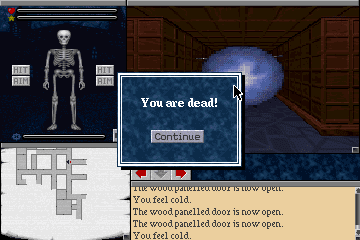 |
| And, as the DOS prompt soon makes it clear, out of this world. |
The same isn’t true of adventure game elements within RPGs. I can’t see any reason not to welcome them (if not done poorly, of course). They provide a break from the monotony of killing enemies, they give you a reason to carefully map and take notes, and they generally help establish a greater sense of setting than the typical RPG dungeon actually gives you. You can tell me that I’m exploring a crypt and maybe create wall textures accordingly, but it creates a much better sense of being in a crypt if I have to solve some kind of puzzle related to headstones or laying some bones to rest or whatever.
My thesis is thus that I, as a CRPG addict, appreciate hybrids more than adventure game addicts. I will need more adventure gamer comments to know for sure. What I can tell you from my perspective is that as I mapped the world of The Legacy, I briefly crossed over and found myself getting annoyed with the game’s RPG intrusions. The game already offers so much to explore, so many puzzles to solve, so many items to keep track of, I don’t need me exploration interrupted (or, worse, artificially channeled) by winged demons roaming the hallways, especially when I don’t know if the winged demons a) can’t be defeated; b) can be defeated, but only with better skills or items; or c) can be defeated but only with a special item. The holy water example above was a real experience in this session. Likewise locked doors: I had a number of them annotated for hours as needing a key, only to find that I just had to try “Force” at least one more time.
After our discussion on my first entry.in which you alerted me that there might be several “walking dead” moments in the game, I started over with new characters. Specifically, I made someone high in “Brawling,” as it was the only way I had to fight for now. When he died, I just used a couple of the default characters. My goal was just to map and annotate, saving the “real” gameplay for later, once I had a better idea of where to go, what resources to expend, and which to conserve. I mapped in my usual way, coloring in yellow those areas where I still had a locked door or other puzzle to solve. The nature of this game is that there are no tricky transitions between areas (e.g., leaving one square to east and arriving in the next from the south), so I could use Excel.
The main floor of the mansion was 20 x 20, using razor walls, with some squares unused–unless there’s some way of finding secret doors I haven’t yet determined. I also mapped about half of the second level (also shaping up to be 20 x 20) and bits of the basement, a third level, and a sub-basement.
 |
| My map of the ground level. The coordinates are for my own notes; I don’t think the game uses any coordinates. |
As I mentioned last time, most of the rooms and hallways are typical RPG-style tiles with textures, in which you can turn and face any direction. Occasionally, however, you move forward into a more detailed room with a more artfully-composed scene, and you can only view it from one perspective. You would think these rooms had something special about them, but most of them haven’t offered me anything important or even any obvious puzzles for later solutions. Level 1’s sole room of this nature was a dining room. The dining room table had “death awaits!” scrawled in it, and a shrunken head came out of the dumbwaiter. A curtain, when opened, showed a hanging body behind it.
Level 2 had three special rooms: a bedroom, a bathroom, and a den. The den had a VCR that I needed so that was important, but otherwise I didn’t see any point to them. Oddly, the first time I visited the bathroom and opened the toilet, I would swear that the game told me that I found a key. But upon dying and revisiting a couple of times, I never got that message again. I never saw the key the first time, in any event, just the message.
 |
| The bathroom scene on Level 2. |
The ground floor had about 15 zombies, and my third character was able to fully clear them, although he had to use up two first aid packs and about 12 rounds of ammunition in the process. Late in the game, I found a “Juju fetish” that causes the zombies to ignore you. I don’t know if it would still be worth killing them for the experience. For weapons, I found a fireplace poker and a revolver and several speedloaders for it, but it eventually jammed.
The only other enemy on the first level was a floating mouth with sharp teeth and tentacles–kind of like a beholder (which is what I called them on the map) without the eye. I couldn’t defeat it with any weapon, but he didn’t seem interested in attacking me unless I attacked him first. Instead, he just floated around and scared the character, which causes him to drop his jaw and stand in place, paralyzed, for a little while.
 |
| I’m not sure it’s even necessary to fight these guys. |
The other floors were a lot harder. The second floor had ghosts, which I could only kill once I figured out the holy water trick, and I think there are more ghosts than holy water. Late in the session, I found what is perhaps a way to remove them all permanently at once, but more on that in a bit. The second floor also had winged demons with some kind of magic ranged attack, and I couldn’t kill them at all. Enemies are fortunately unable to open doors, so you can get away from most of them as long as you don’t get trapped in a dead end.
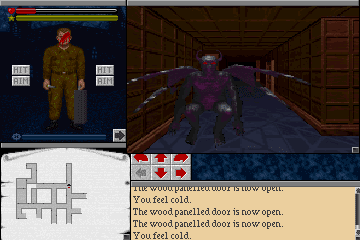 |
| So far, I’ve been unable to defeat this enemy. |
The basement had some other kind of demon that I could kill, but only with a lot of difficulty, and there were too many of them. I could barely explore down there at all. A second basement area had some creature (or person, I suppose) with a gun who kept sniping me from the end of a hallway. Late in the session, I found a bulletproof vest that’s probably supposed to be used here.
In addition to enemies, frequent darkness has been an obstacle to exploration. The lights go out at regular intervals (in conjunction with peals of thunder) and stay out for several minutes, the intervals of darkness getting longer and longer, until eventually they go out completely. I eventually found a flashlight in a Level 1 hallway, but it has limited battery power, which means you definitely want to select “pause” when you take time away from the game window. I eventually found a fuse box behind a locked door, but the game says that it’s broken.
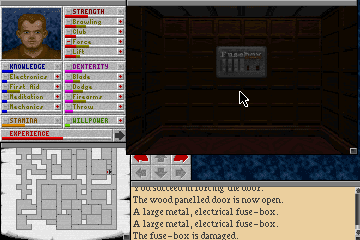 |
| Of course it is. |
The only puzzles I’ve solved have been relatively obvious ones. For instance, I’ve found a handful of keys (thankfully, there’s a key ring) to open locked doors. One key opened a safe, in which I found a videocassette that played in a machine on the second level. Level 1 had a couple of trap doors that could be hidden with wall switches, plus one room where every square spun me in a different direction. A couple of illusory walls were revealed by walking directly into them.
Level 2 got a bit harder with the navigation puzzles. There are a couple of doors that teleport you to other parts of the level when you walk through them. There are a couple of squares in which you get zapped with a lightning bolt unless you press a button on either side to teleport past them.
Other puzzles to which I haven’t found solutions are as follows. I emphasize that I do not want spoilers for these puzzles unless the solution is something that I should have already figured out from the manual or something equally obvious.
- Several locked doors, though it was late in the session that I realized trying “Force” multiple times sometimes works, so I have to go around to them again.
- One particular locked door on Level 2 has someone knocking behind it. This is the subject of the top screen shot and it legitimately gave me a fright when I walked up to it and heard the knocking. That was the only real “scare” of the session.
- A woman walking around in circles on Level 2 doesn’t seem to have any way to interact.
 |
| I can’t get her to stop, talk, or anything. |
- The sealed entry door on Level 1, though I suspect that isn’t a real puzzle but just something that persists throughout the game.
- Some of the rooms have rune symbols on the walls. Examining them says that they’re “charged,” but I have otherwise no idea what to do with them. You can also find runes to pick up that are equally mysterious.
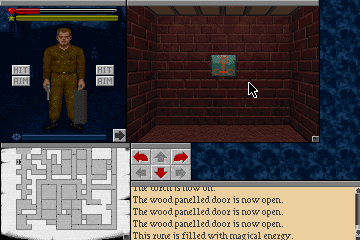 |
| I hope the meaning and use of these becomes clear. |
- The damaged fusebox on Level 1.
- Second-floor landing doors in the entry hallway that are all “nailed shut.” More than once, I’ve written off such doors only to later find a prybar, so I’m not sure what to think here.
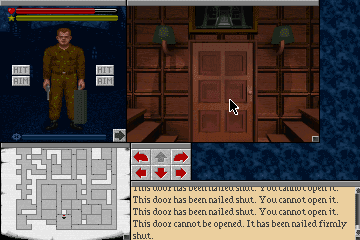 |
| This is the door that the opening cinematic shows you going through. |
But most of my progress is blocked by enemies, not puzzles. I need to figure out reliable ways to defeat the basement demons and winged demons or I won’t be able to explore much of their levels. Your comments have made me reluctant to waste spells on them, and my last couple of characters didn’t have spells anyway.
As I’ve explored, notes, diary pages, and other bits of exposition have filled in parts of the plot. Last time, I recounted a series of notes from a Marcus Roberts, who had taken it upon himself to investigate the house and its “depraved” history, noting that local disappearances corresponded with lights appearing in the sky every 50 years. Inside the house, he found portals to “planes of darkness” that let the demons into the place. He somehow determined that he needed to find the Golden Torch, but he apparently died in the basement from the gun-wielding enemy.
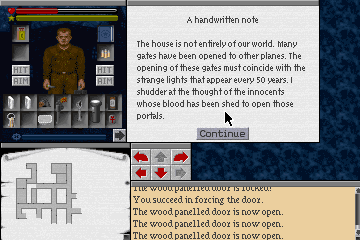 |
| One of Marcus Roberts’s notes. |
One long document described the history of the house: Built “near Longport in 1639 by Governor Elias Winthrop.” There is, of course, no “Longport” anywhere in New England (although there is one in New Jersey) and no Governor Elias Winthrop, but these names sound plausibly like something that you might find in the history of the New England states, particularly Massachusetts. A John Winthrop was a colonial governor of Massachusetts only a few years after 1639, for instance. Anyway, Elias Winthrop was burned as a warlock in 1662–apparently the subject of the painting in the first room. Even then, Winthrop House was said to be haunted. Elias’s son, Hildebrand, used the house for “debauched revelries” until he died in a fire in 1699. The history notes that Hildebrand Winthrop was the last Winthrop to live in the house, but the family tree shows he had two sons who changed their last names to Maitland and Mayhew. I thus don’t know whether the history means they didn’t live in the house (and it later found its way back to their descendants) or whether they lived in the house but weren’t Winthrops anymore.
There were also diary pages written by a Robert Prentiss, one of the three family members who had recently “gone missing” and prompted the start of the game. The diary is recent. It talks about ghostly intrusions from the “ethereal plane” and Prentiss’s attempts to control them. Apparently, some forthcoming stellar alignment is going to cause (or already caused) the “final gate” to open. Prentiss also questions whether he is The One, which has something to do with the magic in his bloodline. His sister, Ellen, apparently also possessed the magic but “rebelled against it,” and Prentiss was determined to kill her, “and then nothing shall stand in my way.” One note written by Ellen calls her brother a “fool” and says that he may be summoning dark gods, including one named Alberoth, but they can’t stop her from running past them on the stairs and exploring the house at her leisure.
These notes seem to be setting up Ellen as a good guy and Robert as the antagonist, but then we come to the VHS tape titled “My Brother and I” (ah, 1993 was a more innocent time). On it, Robert says that Ellen has escaped after being locked up, presumably in the house, after she tried to burn it down in 1967 (she would have been 25). Ellen killed Robert’s wife Catherine and their mother, Karen, “and now she’s after me.” Then Ellen appears on the tape, holding an axe, and says, “Why don’t you tell ’em the rest, brother dear? About your mother and her family, about the ring, about the Dark Ones?” It cuts off there. The title suggests that Ellen survived the encounter.
 |
| I’m not looking forward to meeting her. |
A third note seems to be written by a private investigator, hired by a “weird guy” to “investigate this crazy joint.” It could be Marcus, but the tone is different. He remarks that “nowhere is safe unless it is marked with a strange triangle symbol.” The book mentions this, too, as the only places safe to rest, but I haven’t found a single room with a triangle symbol. The game says I haven’t gotten tired enough to rest anyway.
Finally, I found a ghost on the second level who was interested in talking rather than fighting. He said that he and his fellow ghosts “served the cult of Melchior in life and now are enslaved to it in death.” Apparently, the cult performed something called the Rite of Opening, but Melchior deceived his followers and ensnared their souls. I can release them if I burn “the painting.” The only painting I’ve found is of the warlock in the first room, but I can’t seem to make anything happen with oil or matches or the “Flames of Desolation” spell. However, in messing with it, I noted something I missed earlier: there’s a hollow depression where the warlock’s pendant is, and the game says it’s surrounded by fragments of green glass. Thus, I suspect there’s something else to do with this painting and the one that the ghost wants burned is a different one.
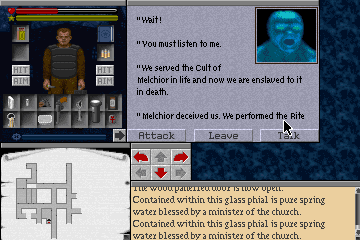 |
| Does the Cult of Melchior worship him because he brings gifts of gold? |
I’m enjoying the game, but it’s clear by now this is no quick adventure game that you can win in less than an hour once you know all the puzzle solutions. Thus, I’m not sure I want to keep exploring with throwaway characters. I guess the better approach would be to do my best with a final character but save at key stages. I’ll think on it for next time.
Time so far: 7 hours
Original URL: http://crpgaddict.blogspot.com/2020/06/the-legacy-plan-all-your-moves-in.html
